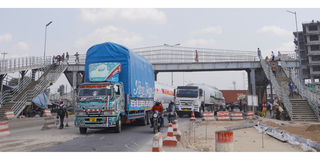Prime
Dar es Salaam’s pedestrian bridges evolve into social hangouts, photo hotspots

View of the Buguruni pedestrian bridge in Dar es Salaam. Photo | Paulo Mungo-TASUBA
What you need to know:
- Initially designed to improve safety and ease pedestrian movement across busy roads, these structures are increasingly drawing residents and visitors who pause to admire city views, take photos and spend time with friends and family
Dar es Salaam. What were once purely functional pedestrian bridges and flyovers in Tanzania’s commercial capital have steadily transformed into informal leisure and photography spots.
Initially designed to improve safety and ease pedestrian movement across busy roads, these structures are increasingly drawing residents and visitors who pause to admire city views, take photos and spend time with friends and family.
Popular sites include Morocco in Kinondoni, Buguruni Bridge, Manzese Bridge, Ubungo Bus Terminal and the Kijazi Flyover.
On weekends and holidays, these locations bustle with families, couples and young people enjoying sunsets, snapping pictures or simply unwinding, while vendors sell snacks and refreshments.
At Buguruni Bridge, groups gather in the evenings to share meals and capture memories.
“The truth is, there’s a pleasure in being here. Ever since we were young, this place has been more than just a bridge. It carries history. It’s part of my memories and a place to unwind,” said resident Elias Kabali.
Mr Kabali dismissed criticism that using bridges as picnic spots was unsophisticated.
“This bridge is the symbol of this area, so why shouldn’t locals use it the same way others use their landmarks for pictures and preserving memories?” he asked.
Another resident Sharifa Hamadi, said the bridge was playing a vital role in family recreation.
“Sometimes, as a parent, you can’t take your children to discos, but being here makes it easier. Even without much money, you can prepare food, let the children eat, then walk around and take photos. It’s a simple way to enjoy and bond,” she said.
The newly launched East Africa Commercial and Logistics Centre (EACLC) in Ubungo has also become a draw, with its glass-floor rooftop offering panoramic city views.
Entrepreneur Sufiani Abdallah likened it to China’s Zhangjiajie glass bridge.
“Personally, I really liked the design. It gives me the same experience,” he said, adding that critics overlook the value of such local attractions.
For Ibrahim Khatibu, the development itself is an attraction.
“If you see progress like this, that alone is enough. I prefer coming here with my family rather than missing out on what’s right in front of us,” he noted.
The bus terminal behind the EACLC is increasingly popular with students and young creatives, while musicians and content creators use the calm surroundings as a backdrop for videos.
Even locations where access is restricted, such as the Kijazi Flyover, draw residents for exercise, photoshoots, and social gatherings. Similarly, the bridge at Magufuli Bus Terminal, built to serve travellers, now attracts locals seeking a breeze and relaxation after a long day.
These developments highlight Dar es Salaam’s creativity, as residents repurpose functional infrastructure into spaces for leisure, photography, and family interaction.





